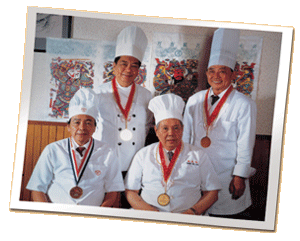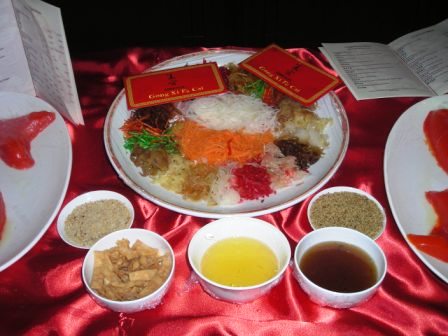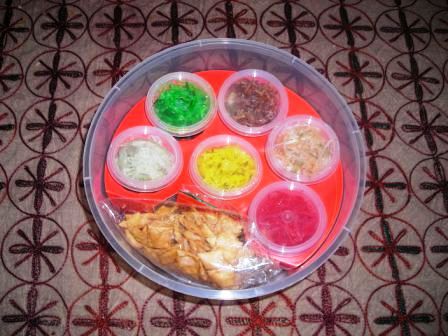
| Home | Chinatowns of the world | Festivals | Culture | Food Culture | History | Countries |
| Chinese Religion | Tours | Sitemap | Documentaries | About | Contact |
Yu Sheng, 鱼生Yu Sheng, 鱼生, is a raw fish salad dish consumed on the 7th day of the Chinese New Year. The dish consists of strips of raw fish and vegetables mixed with spices and sauces. The ingredients are presented separately and are mixed together either by the waitress or diners. In more up market restaurants, the waitress will greet diners with auspicious greetings as she adds each ingredient onto the plate. When the ingredients are added, diners begin the ritual of “lo hei”, 捞起, when they stand around the dish to toss the ingredients as high as possible to symbolize rising prosperity. This action is usually accompanied by shouts of “huat”, 发, meaning prosperity. Yusheng was inspired by the Cantonese custom of consuming raw fish strips during the Chinese New Year. Its present form and consumption style was invented by 4 master chefs in Singapore during the 1960s. These master Chefs were Master Chef Hooi Kok Wai Mr. Tham Mui Kai, Mr. Sin Leong, Mr. Lau Yoke Pui. Master Chef Hooi founded the Dragon Phoenix Restaurant while Master Chef founded the Lau Wah Restaurant. The Master Chefs added new ingredients and weaved symbolic meaning into the dish and presentation. The culinary invention was extremely and became a permanent feature during Chinese New Year celebration in Malaysia and Singapore. Yusheng also spread to other Chinese communities around the world. Yusheng is usually available from the 7th day of the Chinese New Year. It is available in almost all Chinese from the high end restaurants and 5 star hotels to the neighborhood coffee shop. In a restaurant, Yusheng is consumed as the first dish of the lunch or dinner. Many companies organise a New Year lunch for their staff and the first dish will deinfately be Yusheng. To suit the preferences of consumers, vegetarian Yusheng are available for vegetarians. For people who prefer home dining, Yusheng kits are available from supermarkets for a DIY Yusheng at home. As a Chinese New Year dish, Yusheng resonates with people’s aspiration and hopes for the New Year. It explains Yusheng’s popularity and its spread for almost half a century. Related articles:
|
|
| Join us on | Youtube | |||
| Copyright © 2007-24 Chinatownology, All Rights Reserved. | ||||



